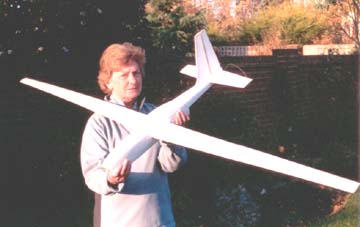

This article is by way of an apology to Trevor for promising to cut him a set of foam cores, monopolising the Club hot wire cutter for 6 months and not actually delivering the goods.
One of my Sailing Club friends works for the company that imports Grob aircraft and I was idly looking for Grob on the Net one evening when I saw this amazing aircraft, a sort of military motor-glider with a 90ft wing and a Garrett gas turbine. As the lads say, "it just had to be done".
I dithered around a lot trying to get more details until my friend turned up one day with an armful of 3-views and some stunning photographs. Later, she got me a full-size (!) set of fuselage cross-sections. Overkill!
I had never cut foam until I tried to make the wings for the Egret. I watched while some were cut at one of the Club nights last year, and have read the occasional article, but these wings are long and very thin. One core seemed fine but I just could not get the other one to work at all. Eventually I covered the good one with 1/32 sheet and thinned white glue, but the other is still an example of how not to make foam wings.
The fuselage was far more interesting. It has a regular section for most of its length so sections are easily cut, using the centre line as datum and making a top half first, from which everything hangs or is fixed. I used ordinary white foam from Jewsons, which cuts, well, like foam and, despite what I had heard, is reasonably easy to sand, although very messy. I used the best part of a whole sheet learning about the process (all of £5.00) and ended up with a respectably recognisable fuselage, undercarriage pods and cockpit canopy. Sanding tends to drag lumps out of the foam, but a lightweight filler (I used Pollyfilla "Light & Easy", which is light, and yes, easy to use) makes even the roughest parts look smooth. I glued the sections together using Aliphatic resin which made a strong and sandable joint. Stress points on the fuselage were reinforced with thin ply.
The tail sections are from thin slices of foam, cut to plan and edged with soft 1/8" balsa. When dry, the foam is cut to the thickness of the edges using the hot wire cutter. This way, you can get tapering section elevator and rudder accurately and simply.
The motor (with Rondo ESC) was a simple push fit into the nose section, which had an internal tube hot wire cut into it. I glued a former on the front to take the mounting bolts for a plain 6V SP 400. Fortunately the little Graupner spinner is a good match for the real thing. The Rx, switch and servos are taped on to the inner surfaces of the foam, near the tail (it's got a long nose and needs some weight at the rear) so that the battery would nestle under the wing at the c of g - I hoped.
The wing is banded on internally and the battery is held in place by foam packing pieces. I didn't paint it, in the very sensible traditions of electric modelling, as it all might be a waste of time!